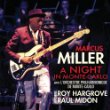Marcus Miller is one of those artists who many listeners hear but often don't see. Luther Vandross fans heard Miller when the bassist worked with the late soul legend in the 1980s. Fans of cinema heard Miller's rumbling bass lines on the theme to the movies Boomerang and Skool Daze. Jazz-fusion adherents likely have the most knowledge of Miller's work. A Miles Davis fan knows that Miller joined Davis' fusion group after the legendary trumpeter returned to music after a hiatus that started in the mid-1970s and ended in the early 1980s. More recently, Miller has been a frequent collaborator on plenty of jazz, R&B and hip-hop recordings when he is not making albums that merge jazz with a variety of genres. Recent examples of both include his 2008 album Marcus and his collaboration with two other legends of the electric bass - Stanley Clarke and Victor Wooten.
Marcus Miller is one of those artists who many listeners hear but often don't see. Luther Vandross fans heard Miller when the bassist worked with the late soul legend in the 1980s. Fans of cinema heard Miller's rumbling bass lines on the theme to the movies Boomerang and Skool Daze. Jazz-fusion adherents likely have the most knowledge of Miller's work. A Miles Davis fan knows that Miller joined Davis' fusion group after the legendary trumpeter returned to music after a hiatus that started in the mid-1970s and ended in the early 1980s. More recently, Miller has been a frequent collaborator on plenty of jazz, R&B and hip-hop recordings when he is not making albums that merge jazz with a variety of genres. Recent examples of both include his 2008 album Marcus and his collaboration with two other legends of the electric bass - Stanley Clarke and Victor Wooten.
A musician who works with Miles Davis, Luther Vandross and Stanley Clarke clearly has game, so it's no surprise that artists like singer/songwriter Raul Midon and trumpeter Roy Hargrove gladly shared the stage when Miller's band performed a concert in Monte-Carlo with the Philharmonic Orchestra of Monte-Carlo. The live album Marcus Miller: A Night in Monte-Carlo resulted from that collaboration.
By recording a live album, Miller takes jazz away from the studio and places it in the venue where it is best enjoyed - in front of a live audience where the crowd can see the musicians communicating with each other and creating. Presenting jazz in an orchestral setting enlarges the sound of the jazz and shows how adaptable both jazz and symphonic music can be. Combining jazz with orchestral music isn't new. Charlie Parker made an album that combined his saxophone playing with strings. Miller's mentor, Miles Davis, made several recordings with a full orchestra before he went electric in the late 1960s.
A Night In Monte-Carlo includes "I Loves You Porgy," a tune from the George and Ira Gershwin opera Porgy and Bess that Davis recorded in an orchestral setting back in the 1950s. In fact, Davis's influence is palpable on the recording A Night in Monte-Carlo. Miller performed "So What" from Davis' Kind of Blue album. The performance features the Philharmonic Orchestra of Monte-Carlo's string section reprising Bill Evans' introduction. Most performances of "So What" skip that intro, and it was a nice touch to hear it in this fusion between jazz and symphonic music. A Night in Monte-Carlo also includes "Amandla," a song Miller wrote for Davis in the 1980s.
Miller brings all of his influences together on A Night in Monte-Carlo. The performance of the Middle East tinged "Blast!" includes a turntable solo. Midon's wonderful vocals and guitar playing take center stage during a rendition of his song "State of Mind." That song also features Midon performing a solo in which he employs his ‘mouth trumpet' (Midon is known for being able to vocally recreate the sound of a trumpet). Midon performs an amazing mouth trumpet solo on "State of Mind" which is made more incredible by the fact that the great Roy Hargrove plays the trumpet on several tracks. I'm still trying to figure out if that's all Midon on "State of Mind," or if he and Hargrove performed a ‘trumpet duet.'
Of course, that's the great thing about jazz and jazz musicians. They never cease to surprise and impress their audiences. They seemingly can play or sing anything. That virtuosity shines through on A Night in Monte-Carlo because the qualities that make live recordings so great are always present in jazz regardless of the venue. Recommended.
By Howard Dukes

